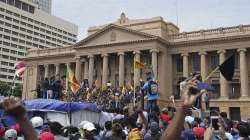Sri Lanka protests turn wild: What pushed country into a crippling economic crisis | Explained
Sri Lanka has been reeling under its worst economic collapse ever, muddling through with aid from India as its leaders try to negotiate a bailout with International Monetary Fund. But what led to the crisis? We break it down into 6 points.

Sri Lanka witnessed its biggest protest on Saturday as thousands of citizens took to the streets their agony over the island nation's crippling economic crisis. Lankans blamed President Gotabaya Rajapaksa for the economic situation and marched into his house. The country has been reeling under its worst economic collapse ever, muddling through with aid from India and other countries as its leaders try to negotiate a bailout with the International Monetary Fund.
Quick updates on what's going on in Lanka currently
- Sri Lankan protesters stormed President Gotabaya Rajapaksa’s residence and nearby office on Saturday. Tens of thousands of people took to the streets of the capital Colombo their agony against the crisis.
- Videos posted on social media showed protesters storming the residence, chanting “Gota go home,” calling the president by his nickname. Dozens were seen jumping into the pool, milling about the house and watching television. Outside the building, barricades were overturned and a black flag was hoisted on a pole.
- At least 30 people, including two policemen, were injured in clashes between security personnel and protesters – some of them holding Sri Lankan flags and helmets.
- According to sources, the President had been moved out of his residence on Friday, in anticipation of Saturday's protests.
- Sri Lankan Prime Minister Ranil Wickremesinghe resigned to make way for an all-party government to take over the country.
- Earlier on Saturday, police had earlier lifted the curfew imposed in seven divisions in the country’s Western Province, including Colombo, ahead of the planned anti-government protests, after coming under sustained pressure from top lawyers’ associations, and human rights groups, and political parties.
But what led to the crisis? We break it down into a few key points.
1. Lack of foreign exchange
The country's economic crisis can be rooted in a shortage of foreign exchange. This means that the country imported more than it had exported. This led to the government not being able to pay for imports for staple foods and fuel.
2. Inflation
Lanka's import rates had resulted in an inability to pay for basic items such as food, fuel etc. This led to a rise in prices, leading to inflation. To control inflation, Lanka's central bank raised its interest rates to highest in 20 years. Now, the country's currency stands as the worst-performing currency globally.
3. Tourism
Another major factor that contributed to the Sri Lankan economy's downfall is the nation's fallen tourism. Tourism adds to 10% of the country's GDP. During the 2019 Easter bombings, the industry fell by a major amount. The Covid-19 pandemic added fuel to the fire. Tourism earned Sri Lanka $4.4 billion and contributed 5.6% to GDP in 2018, but this dropped to just 0.8% in 2020.
4. Foreign debt
The nearly-bankrupt country, with an acute foreign currency crisis that resulted in foreign debt default, had announced in April that it is suspending nearly $7 billion foreign debt repayment due for this year out of about $25 billion due through 2026. Sri Lanka’s total foreign debt stands at $51 billion.
5. The Rajapaksas' failures
Tax cuts: The President Gotabaya Rajapaksa-led ruling government in the country had made tax cuts that affected the revenue, causing budget deficits to soar. VAT was reduced to 8%, corporate tax came down from 28% to 24%.
Money printing: To cover up the government's economic goof-ups the Central Bank began printing money in record amounts. The IMF had already asked Lanka to stop printing money and instead hike interest rates and raise taxes while cutting spending. On 6 April 2022, the CBSL allegedly printed 119.08 billion rupees, making it the highest reported amount printed on a single day by the CBSL for the year 2022.
Agriculture: In April 2021, President Gotabaya Rajapaksa announced that Sri Lanka will only allow organic farming, banning inorganic fertilizers and agrochemical-based fertilizers. This led to a drop in production, resulting to losses of around $425 million and creating a 20% drop in rice production within the first six months of the policy alone. Gota was forced to pull back the policy.
6. Russia Ukraine war
Russia is the second biggest importer of Sri Lankan tea, and the country's ongoing invasion of Ukraine took a toll on the country's trade. With the sanctions on Russia, tourism also saw rippling effects in Sri Lanka.
What Lankans have been facing due to the economic crisis
Sri Lankans were in the direct impact zone of the country's economic collapse. Images of people standing in long queues for fuel, basic necessities went viral on social media. Medicines and food were some basic essentials that were far from available for Lankans. Jobs were lost as the country's poverty rate rose to high levels. Oil prices took a steep hike, and authorities announced that the island nation can run out of fuel stocks any time now. Power cuts also featured on major levels, and electricity was cut for over 15 hours a day in many places.
(with agencies inputs)